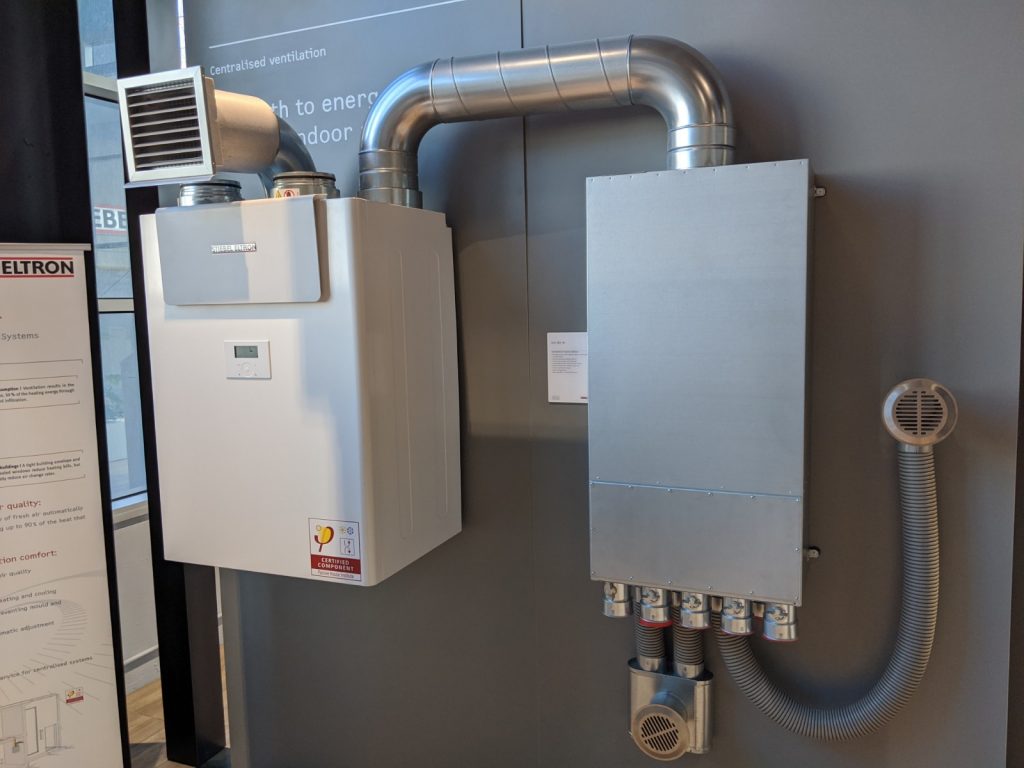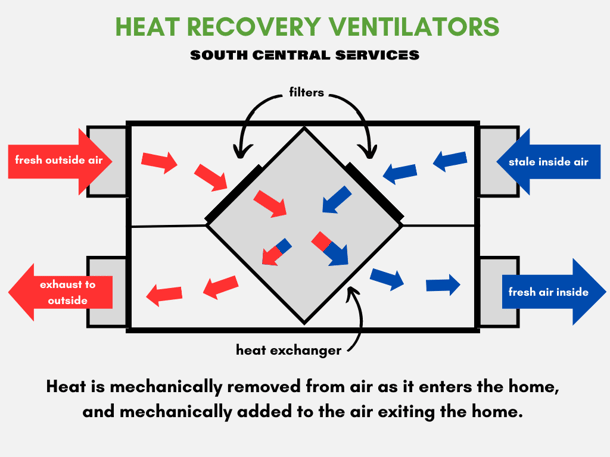Revealing the Key Benefits and Uses of Heat Recovery Ventilation in Lasting Style
Heat Recovery Ventilation (HRV) systems play a vital function in sustainable layout. They assist in a continuous exchange of stagnant indoor air with fresh outdoor air, significantly boosting indoor air high quality. Moreover, HRVs add to energy performance by redeeming heat from worn down air, which can reduce energy expenses. Understanding the complex benefits and applications of HRVs discloses their significance in modern style. What various other advantages do these systems offer in the search of sustainability?
Recognizing Heat Recovery Ventilation Systems
Heat recovery ventilation (HRV) systems are developed to improve indoor air high quality while reducing energy loss. These systems utilize a mechanical air flow approach to exchange stale indoor air with fresh outside air, guaranteeing a continual supply of clean air. By recording warmth from the exhaust air, HRVs precondition inbound air, reducing the demand on home heating and cooling down systems. This process not just improves thermal comfort however also adds to power efficiency in household and commercial buildings. Additionally, HRV systems help manage humidity degrees and reduce indoor toxins, advertising a healthier living atmosphere. Their strategic implementation is essential for achieving lasting layout objectives, as they offer a balance between energy conservation and owner well-being.
How HRV Solution Work
While lots of might be acquainted with air flow systems, understanding exactly how warm healing ventilation (HRV) systems operate is vital for valuing their benefits. HRV systems work by trading stagnant indoor air with fresh outdoor air while transferring heat between the two streams. This process occurs in a warmth exchanger, where warm from the outgoing air warms up the incoming air during colder months, minimizing power loss. Conversely, in warmer months, the system can cool incoming air making use of the cooler outbound air. HRVs are equipped with followers to promote air movement and filters to eliminate particulates, guaranteeing a constant, balanced air flow procedure. This ingenious design not just boosts energy effectiveness but additionally adds to preserving a comfy interior environment.
Enhancing Indoor Air Quality
Interior air high quality can greatly affect health and health, making effective air flow crucial in modern-day homes. Heat Recovery Ventilation (HRV) systems play a vital role in keeping interior air quality by continuously trading stale indoor air with fresh exterior air. This procedure not only decreases air-borne toxins however also decreases humidity levels, which can bring about mold growth and respiratory system problems. HRV systems filter inbound air, removing irritants and particulates, thus providing a healthier living setting. Furthermore, these systems aid eliminate smells and unpredictable organic substances (VOCs) typically discovered in household products. By ensuring a regular circulation of tidy air, HRV systems add to an overall improved interior environment, advertising comfort and well-being for passengers.
Power Performance and Cost Cost Savings
Power efficiency stands out as a considerable benefit of Heat Recovery Ventilation (HRV) systems. By capturing and reusing the warm from worn down interior air, HRVs minimize the power required for home heating inbound fresh air, resulting in minimized power intake. This effectiveness equates right into reduced energy bills, providing considerable price financial savings for home owners and businesses alike. Additionally, HRV systems often qualify for energy effectiveness motivations and discounts, further enhancing their financial appeal. In time, the initial investment in HRV technology can result in a positive return on financial investment with reduced energy expenses. Consequently, the combination of HRV systems not only promotes sustainable design yet likewise offers a useful service for achieving long-term power cost savings and financial advantages.
Ecological Benefits of HRV

A plethora of ecological advantages occurs from the execution of Heat Recovery Ventilation (HRV) systems. By successfully transferring warm from exhaust air to inbound fresh air, HRVs significantly minimize the power required for home heating and cooling down spaces. This power performance equates to reduce greenhouse gas emissions, contributing to a decrease in the total carbon impact of buildings. Additionally, HRV systems boost indoor air quality by continually flowing fresh air, therefore minimizing the concentration of interior contaminants and allergens. The decrease in power consumption help in conserving natural resources, making HRVs a necessary element of sustainable layout. Overall, the environmental benefits of HRVs play a crucial function in advertising a much healthier planet and cultivating eco-friendly structure practices.
Versatile Applications in Modern Design
Heat recovery ventilation (HRV) systems are increasingly being integrated into both residential and commercial architectural jobs. In household settings, HRVs enhance interior air top quality while optimizing energy performance. Meanwhile, in commercial spaces, these systems enhance air flow techniques, showing their versatility in contemporary architectural applications.
Residential Projects Assimilation
While modern architecture progressively highlights sustainability, the combination of heat recovery air flow systems in household tasks has emerged as a useful option for improving interior air quality and power performance. These systems successfully transfer heat from exhaust air to incoming fresh air, minimizing power loss and decreasing heating or cooling needs. In brand-new builds and retrofits alike, warm healing ventilation can be flawlessly included, supplying house owners with a much healthier living atmosphere while decreasing energy expenses. Furthermore, with enhancing understanding of ecological effects, even more architects and contractors are recognizing the long-term benefits of these systems. Because of this, warmth recuperation air flow has become an important element of sustainable domestic design, showcasing flexibility and commitment to eco-friendly techniques.
Industrial Spaces Optimization
As modern business areas progress to satisfy the needs of sustainability and effectiveness, the implementation of heat recuperation ventilation systems arises as an essential approach for enhancing indoor settings. These systems assist in the exchange of stale interior air with fresh outdoor air while recovering heat power, significantly decreasing power consumption. This not just enhances convenience for occupants however likewise assists in lowering functional costs. Flexible applications can be observed in workplaces, retail areas, and universities, where air quality and temperature control are extremely important. Furthermore, incorporating heat healing air flow aligns with environment-friendly building accreditations, better promoting ecological duty. Ultimately, embracing such systems in commercial design not just adds to sustainability objectives but likewise cultivates healthier, a lot more efficient rooms for users.
Integrating HRV Into Sustainable Style Practices
Integrating heat recovery air flow (HRV) systems into sustainable style methods offers substantial benefits in energy effectiveness and interior air quality. By utilizing HRV, developers can develop economical solutions that not just find out this here minimize power usage however also enhance the overall convenience of interior atmospheres. This positioning with sustainability goals positions HRV as a crucial part in modern-day building techniques.
Energy Performance Improvement
By incorporating heat recuperation air flow (HRV) systems into sustainable layout methods, designers and contractors can considerably enhance energy efficiency in modern-day buildings. HRV systems function by recording warm from outgoing stagnant air and moving it to incoming fresh air, reducing the power required for home heating or cooling interior areas. This procedure not only minimizes reliance on traditional HVAC systems yet also decreases overall power consumption. In enhancement, HRV systems can assist keep a constant interior temperature, lowering peak energy needs. By integrating these systems, structures can attain considerable decreases in utility prices and carbon footprints, lining up with sustainability objectives. Eventually, HRV modern technology stands for a functional option for enhancing energy effectiveness in the constructed environment, promoting even more liable resource use.
Indoor Air Top Quality Improvement
Exactly how can warmth healing ventilation (HRV) systems add to superior indoor air high quality in modern buildings? HRV systems effectively exchange stagnant interior air with fresh outdoor air while recovering warm energy, decreasing temperature level fluctuations. This process minimizes the focus of interior toxins, such as unpredictable organic compounds (VOCs), allergens, and moisture, which can wear away air top quality and impact occupant health and wellness. By maintaining optimal moisture degrees and ensuring a continuous supply of clean air, HRVs help create a much healthier indoor setting. Additionally, these systems can be incorporated into lasting design methods, advertising energy effectiveness along with boosted visit this web-site air high quality. HRV Heat Recovery Ventilation. Consequently, HRV technology plays a vital role ahead of time overall resident comfort and well-being in contemporary building layouts
Cost-Effective Layout Solutions

Regularly Asked Questions
What Maintenance Is Needed for Heat Recovery Ventilation Systems?

Upkeep for warm recuperation air flow systems typically entails normal filter replacements, cleaning of warm exchangers, examination of fans and air ducts, and making sure proper drainage. These jobs help preserve efficiency and extend the system's life-span gradually.
Can HRV Solutions Be Mounted in Existing Structures?
Heat recovery ventilation systems can indeed be set up in existing structures. HRV Heat Recovery Ventilation. Retrofitting calls for careful planning and assessment of the building's layout, making certain compatibility with current systems while taking full advantage of power efficiency and interior air top quality
How Do HRV Solution Influence Sound Degrees Inside Your Home?
HRV systems can affect interior sound degrees by presenting sound from external sources with air flow. High-quality installments frequently integrate sound-dampening features, lessening sound impact while providing efficient air exchange and preserving comfort indoors.
Are There Any Kind Of Downsides to Using HRV Systems?
The downsides of using HRV systems consist of internet prospective high initial costs, upkeep challenges, and the possibility of decreased interior air high quality if filters are sporadically transformed, which could bring about concerns with humidity levels.
How Do I Select the Right HRV System for My Needs?
Picking the ideal heat recuperation air flow system includes evaluating certain needs, such as constructing size, climate, and power performance objectives. Additionally, examining system functions, installation demands, and upkeep considerations is crucial for peak efficiency and fulfillment.